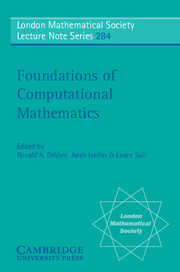Book contents
- Frontmatter
- Contents
- Preface
- Singularities and computation of minimizers for variational problems
- Adaptive finite element methods for flow problems
- Newton's method and some complexity aspects of the zero-finding problem
- Kronecker's smart, little black boxes
- Numerical analysis in Lie groups
- Feasibility control in nonlinear optimization
- Six lectures on the geometric integration of ODEs
- When are integration and discrepancy tractable?
- Moving frames — in geometry, algebra, computer vision, and numerical analysis
- Harmonic map flows and image processing
- Statistics from computations
- Simulation of stochastic processes and applications
- Real-time numerical solution to Duncan-Mortensen-Zakai equation
Singularities and computation of minimizers for variational problems
Published online by Cambridge University Press: 05 August 2013
- Frontmatter
- Contents
- Preface
- Singularities and computation of minimizers for variational problems
- Adaptive finite element methods for flow problems
- Newton's method and some complexity aspects of the zero-finding problem
- Kronecker's smart, little black boxes
- Numerical analysis in Lie groups
- Feasibility control in nonlinear optimization
- Six lectures on the geometric integration of ODEs
- When are integration and discrepancy tractable?
- Moving frames — in geometry, algebra, computer vision, and numerical analysis
- Harmonic map flows and image processing
- Statistics from computations
- Simulation of stochastic processes and applications
- Real-time numerical solution to Duncan-Mortensen-Zakai equation
Summary
Abstract
Various issues are addressed related to the computation of minimizers for variational problems. Special attention is paid (i) to problems with singular minimizers, which natural numerical schemes may fail to detect, and the role of the choice of function space for such problems, and (ii) to problems for which there is no minimizer, which lead to difficult numerical questions such as the computation of microstructure for elastic materials that undergo phase transformations involving a change of shape.
Introduction
In this article I give a brief tour of some topics related to the computation of minimizers for integrals of the calculus of variations. In this I take the point of view not of a numerical analyst, which I am not, but of an applied mathematician for whom questions of computation have arisen not just because of the need to understand phenomena inaccessible to contemporary analysis, but also because they are naturally motivated by attempts to apply analysis to variational problems.
I will concentrate on two specific issues. The first is that minimizers of variational problems may have singularities, but natural numerical schemes may fail to detect them. Connected with this is the surprising Lavrentiev phenomenon, according to which minimizers in different function spaces may be different. The second is that minimizers may not exist, in which case the question naturally arises as to what the behaviour of numerical schemes designed to compute such minimizers will be.
- Type
- Chapter
- Information
- Foundations of Computational Mathematics , pp. 1 - 20Publisher: Cambridge University PressPrint publication year: 2001
- 16
- Cited by



